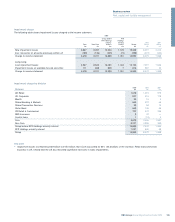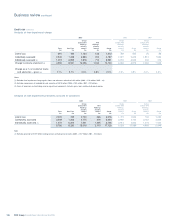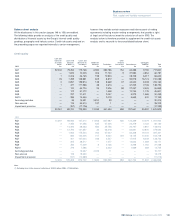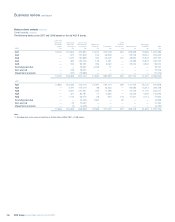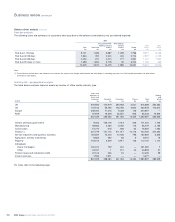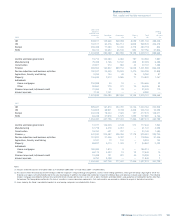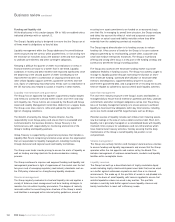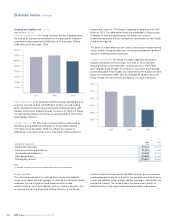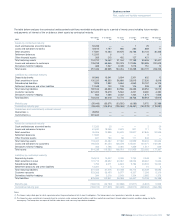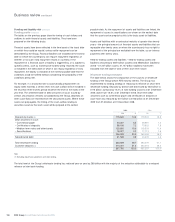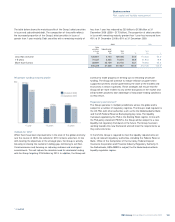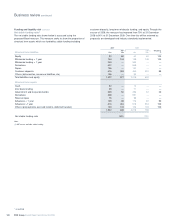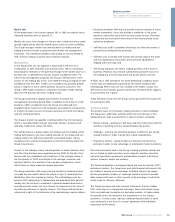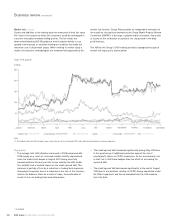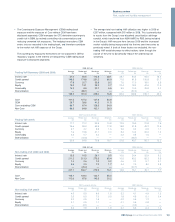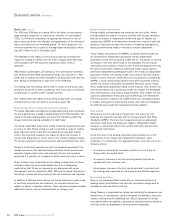RBS 2009 Annual Report Download - page 156
Download and view the complete annual report
Please find page 156 of the 2009 RBS annual report below. You can navigate through the pages in the report by either clicking on the pages listed below, or by using the keyword search tool below to find specific information within the annual report.Business review continued
RBS Group Annual Report and Accounts 2009154
Funding and liquidity risk
All the disclosures in this section (pages 154 to 160) are audited unless
indicated otherwise with an asterisk (*).
The Group’s liquidity policy is designed to ensure that the Group can at
all times meet its obligations as they fall due.
Liquidity management within the Group addresses the overall balance
sheet structure and the control, within prudent limits, of risk arising from
the mismatch of maturities across the balance sheet and from exposure
to undrawn commitments and other contingent obligations.
Following a difficult first quarter of 2009, most indicators of stress in
financial markets are close to or better than in late 2008. Liquidity
conditions in money and debt markets have improved significantly since
the beginning of the second quarter of 2009. Contributing to the
improvement has been a combination of ongoing central bank and
other official liquidity support schemes, guarantee schemes and rate
cuts. Signs of underlying macroeconomic trends such as stabilisation of
the UK economy, also helped to sustain a recovery in debt markets.
Liquidity risk framework and governance
The Group has an approved risk appetite supported by explicit targets
and metrics to control the size and extent of both short-term and long-
term liquidity risk. These metrics are reviewed by the Board and Group
Asset and Liability Management Committee (GALCO) on a regular basis.
The Group uses stress tests to refine and update the risk appetite in
light of changing conditions.
The GALCO, chaired by the Group Finance Director, has the
responsibility to set Group policy and ensure that it is cascaded and
communicated to the business divisions. Group Treasury is the
functional area with responsibility for monitoring and control of the
Group's funding and liquidity positions.
Group Treasury is supported by a governance process that includes a
Liquidity Risk Forum comprising functional areas across the organisation
that are responsible for liquidity management, including monitoring
through divisional and regional asset and liability committees.
The Group uses funds transfer pricing to ensure the costs of liquidity as
well as funding are integrated into the business decision making
process.
The Group continues to improve and augment funding and liquidity risk
management practices in light of experience of the market over the last
two years and of emerging regulatory and industry standards such as
the FSA policy statement on strengthening liquidity standards.
Structural management
The Group regularly evaluates its structural liquidity risk and applies a
variety of balance sheet management and term funding strategies to
maintain this risk within its policy parameters. The degree of maturity
mismatch within the overall long-term structure of the Group’s assets
and liabilities is managed within internal policy guidelines, aimed at
ensuring term asset commitments are funded on an economic basis
over their life. In managing its overall term structure, the Group analyses
and takes into account the effect of retail and corporate customer
behaviour on actual asset and liability maturities where they differ
materially from the underlying contractual maturities.
The Group targets diversification in its funding sources to reduce
funding risk. A key source of funds for the Group is its core customer
deposits gathered by its retail banking, private client, corporate and
small and medium enterprises franchises. The Group’s multi-brand
offering and strong client focus is a key part of the funding strategy and
continues to benefit the Group’s funding position.
The Group also accesses the wholesale funding market to provide
additional flexibility in funding sources. The Group has actively sought to
manage its liquidity position through increasing the duration of short-
term wholesale funding, continued diversification of wholesale debt
investors and depositors, supplemented by long-term issuance,
government guaranteed debt, and a programme of ensuring that assets
held are eligible as collateral to access central bank liquidity schemes.
Cash flow management
The short-term maturity structure of the Group’s assets and liabilities is
managed daily to ensure that all material or potential cash flows, undrawn
commitments and other contingent obligations can be met. The primary
focus of the daily management activity is to ensure access to sufficient
liquidity to meet cash flow obligations within key time horizons, including
out to one month ahead and FSA target horizons such as 90 days.
Potential sources of liquidity include cash inflows from maturing assets,
new borrowings or the sale of various debt securities held. Short-term
liquidity risk is generally managed on a consolidated basis with liquidity
mismatch limits in place for subsidiaries and non-UK branches which
have material local treasury activities, thereby assuring that the daily
maintenance of the Group’s overall liquidity risk position is not
compromised.
Volume management
The Group also actively monitors and manages future business volumes
to assess funding and liquidity requirements and ensure that the Group
operates within the risk appetite and metrics set by the Board. This
includes management of undrawn commitments, conduits and liquidity
facilities within acceptable levels.
Liquidity reserves
The Group has built up a diversified stock of highly marketable liquid
assets including highly rated central government debt that can be used
as a buffer against unforeseen impacts on cash flow or in stressed
environments. The make up of this portfolio of assets is sub-divided into
tiers on the basis of asset liquidity, with haircuts applied to ensure that
realistic liquidation values are used in key metrics. This portfolio
includes a centrally held buffer against severe liquidity stresses and
locally held buffers to meet self sufficiency needs.



